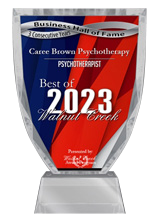You may be aware that these days, people are feeling more anxious than ever. Some blame this anxiety epidemic on overreliance on technology like smartphones and computers, which results in less face-to-face interaction with other humans. Whatever the cause, anxiety is a serious condition that features several common psychiatric disorders. But what if you experience something more than anxiety? Panic attacks involve an intense, overwhelming fear that comes on suddenly and is accompanied by physical symptoms like nausea, racing heartbeat, and shortness of breath. While the Diagnostic and Statistical Manual of Mental Disorders (DSM-5) recognizes panic attacks, there is no diagnostic recognition of anxiety attacks, leaving the exact definition of anxiety open to interpretation. Caree Brown, psychotherapist, can help you determine if you are experiencing anxiety or panic attacks.
Symptomatic Similarities and Differences
Panic attacks and anxiety attacks may feel similar because they share many physical and emotional symptoms. In fact, it is possible to experience both panic and anxiety at the same time.
Symptoms of Anxiety Attacks
Symptoms of anxiety attacks include worry, stress, and fear. These symptoms can come on gradually and are usually related to the anticipation of a stressful event or situation.
Symptoms of Panic Attacks
Panic attacks occur for no obvious reason. DSM-5 categorizes panic attacks as expected or unexpected: Expected panic attacks are set off by external stimuli like phobias.
Panic attacks can happen to anyone at any time; however, if you experience this more than once, you may have a panic disorder. Caree Brown is a top psychotherapist and can help you determine if you have an anxiety or panic disorder.
The Overlap Between Panic and Anxiety
Sometimes, an anxiety attack can snowball into a full-blown panic attack. For instance, if you are feeling anxious about a stressful situation, that anxiety may culminate in panic when the situation arrives.
How to Tell the Difference Between Panic and Anxiety
Anxiety is brought on by outside stressors
Panic comes on out of the blue
Anxiety can be mild/moderate/severe
Panic is always severe
Physical symptoms of anxiety are mild-to-moderate
Physical symptoms of panic are intense; Fight-or-Flight Response takes over
Anxiety builds gradually
Panic starts suddenly
Anxiety triggers fear of future anxiety. This can lead you to avoid situations and places which you are concerned might lead to another attack
For help determining whether you are experiencing panic or anxiety, contact Caree Brown, psychotherapist.
Causes of Expected Panic Attacks and Anxiety Attacks
Expected panic attacks and anxiety attacks can be caused by similar things like a stressful job, social situations, or phobias. Other possible triggers include chronic pain, thyroid problems, and driving rage or fear.
Unexpected panic attacks have no known cause.
Risk Factors of Panic Attacks and Anxiety Attacks
The two types of attacks share similar risk factors, including trauma, stress, chronic illness, you or a close friend or family member having another mental health issue, abusing drugs or alcohol, or being female. Caree Brown is a psychotherapist who provides support for many different mental health issues.
People who experience anxiety are at increased risk for panic attacks; however, it is not a clear indicator you will experience panic attacks.
How to Care for Yourself
Practice Deep Breathing
When you start to panic, you will feel your breath get shallow and fast. Focus on taking slow, deep breaths. Feel your stomach fill with air as you inhale, then count to four as you exhale. Repeat this pattern until you feel calmer.
Consciously Recognize that You’re Having an Attack
If you can recognize that you are experiencing the symptoms of a health condition just like any other, you can remind yourself that the symptoms will pass. This can help you get through the hardest part, knowing you’ll be alright.
Practice Mindfulness
Mindfulness-based interventions are used increasingly to treat panic and anxiety disorders. You can practice being mindful any time by sitting still and observing your thoughts without reacting to them. This is good training for when your mind gets “out of control” and you want to be able to respond as calmly as you can.
Medical Treatments
Talk to your psychotherapist about the medical treatments available to you. These may include antidepressants, antianxiety drugs, or benzodiazepines to help you stay calm and balanced.
Psychotherapist
Caree Brown provides counseling for individuals, couples, marriages, and families. A licensed psychotherapist, Caree was voted “Best of the Bay Psychotherapist 2010” and “Best Therapist in Northern California 2011” by KRON Channel 4 television. In 2013 and 2014 the City of Walnut Creek honored her as “Best Psychotherapist in Walnut Creek.”
Call Carrie at 925-878-5587 or visit her Contact page for more information.



